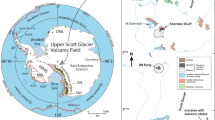Abstract
Many objections have been raised as to the ability of subcontinental lithospheric mantle to produce voluminous amounts of basalt, because this upper part of the mantle is thought to be refractory, and the geotherm is rarely above the peridotite solidus at these depths under continents. However, in the Pacific Northwest of the USA during the Neogene, the subcontinental lithospehric mantle has been proposed as a key source for basalts erupted within the northern Basin and Range, and for the Columbia River flood basalts erupted on the Columbia Plateau. An alternative explanation to melting in the subcontinental lithospheric mantle, which equally well explains the chemical compositions thought to originate there, is that these magmas were contaminated by crust of varying ages. Calc-alkaline lavas, which occupy the Blue Mountains in the center of this region, hold clues to the latter process. Their elevated trace element ratios (e.g., Ba/Zr, K2O/P2O5), coupled with differentiation indicators such as Mg? [molar Mg/(Mg + Fe)], and Sr, Nd, and Pb isotopic compositions, can most reasonably be explained by crustal contamination. Appraisal of continental peridotite xenolith data indicates that high trace element ratios such as Ba/Zr in continental basalts cannot result from melting in the subcontinental lithospheric mantle. Instead, as with the calc-alkaline lavas, these high ratios in the tholeiites most likely indicate crustal contamination. Furthermore, the peridotite xenoliths do not have a relative depletion in Nb and Ta that is observed in most of the lavas within the region. Relatively minor volumes of tholeiites erupted in late Neogene times in the northern Basin and Range (Hi-Mg olivine tholeiites) and Columbia Plateau (Saddle Mountains basalts), are the only lavas which have trace element and isotopic compositions consistent with being derived from, or largely interacting with a subcontinental lithospheric mantle in the Pacific Northwest. In contrast to the prior studies, we suggest that the mantle sources for most of the basalts in this region were ultimately beneath the lithospheric mantle.
Similar content being viewed by others
Author information
Authors and Affiliations
Additional information
Received: 23 December 1994/Accepted: 2 May 1995
Rights and permissions
About this article
Cite this article
Brandon, A., Goles, G. Assessing subcontinental lithospheric mantle sources for basalts: Neogene volcanism in the Pacific Northwest, USA as a test case. Contrib Mineral Petrol 121, 364–379 (1995). https://doi.org/10.1007/s004100050102
Issue Date:
DOI: https://doi.org/10.1007/s004100050102




